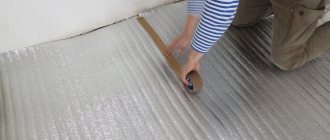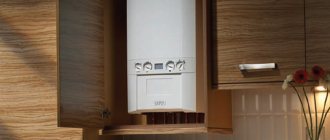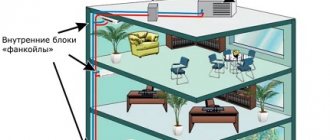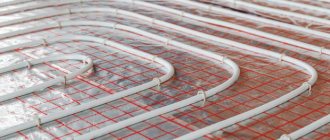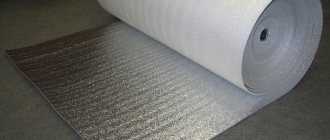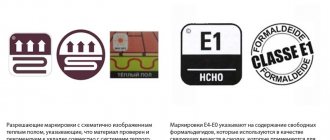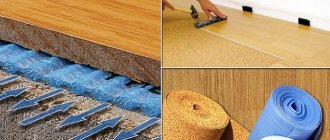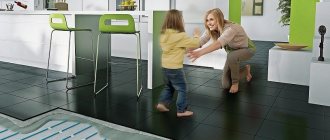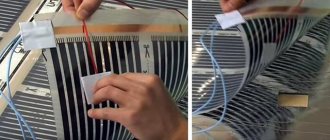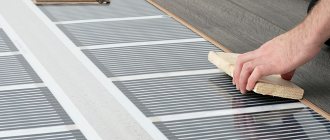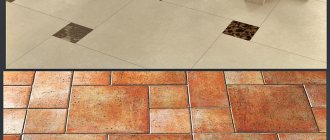Today, the underfloor heating system is extremely popular. This is due to a large number of positive qualities, as well as the possibility of installing any type of flooring. In addition, you can choose absolutely any option for the heating system, depending on the need and the room itself. But it is worth noting that when installing all components of a heated floor, special attention should be paid to the thermal insulation layer so that heat is not wasted just like that. An excellent option here would be underfloor heating. The main thing is to know which one to choose.
Substrate requirements
The main material for underfloor heating is polypropylene, foamed polyethylene. They are covered with lavsan film having a metallized layer. The latter serves for uniform heat distribution. All other components do not allow heat to escape to the floors below, but are completely transferred into the room to warm the air from the base of the floor.
The porous underfloor heating substrate has very high permissible temperatures, reaching up to 90 degrees. This allows heating elements to be laid directly on the film. All this indicates the excellent thermal and waterproofing qualities of the material. In addition, there are other qualities that the substrate has - sound insulation and a high degree of reflection.
Each element of the substrate for pouring the floor has a special marking resembling a grid. This facilitates quick and high-quality distribution of the heating cable of an electric heated floor over the surface, depending on the step that is selected.
The substrate allows you to save about 80-90% of thermal radiation. In this case, all energy costs are reduced to a minimum.
Underlay for laminate
When choosing a base for a heated floor, special attention is paid to compatibility with the decorative coating that will sit on the heated layer . Despite the fact that the substrate will be separated from the floor surface precisely by heating elements, its relationship with the final coating involves its own nuances. The features of this combination can be considered using the example of the most sensitive finishing surface - laminated boards . Although the production of laminate does not involve the direct use of solid wood, the structure of this material contains wood inclusions that give the coating the appropriate characteristics . As a result, the panels adopt both the pros and cons of a regular board . It is worth noting that the underlay for a heated floor under a laminate, unlike other decorative coatings, is a prerequisite .
In addition to eliminating the risk of damage to laminated panels as a result of heating the floor, the base under the heated floor acts as a sound insulator , which reduces the noise generated during the operation of the floor, without transmitting vibrations and vibration effects to the finishing surface . In this regard, the optimal height of the flooring under the laminated covering should be from three millimeters . During the operation of the floor, such bases are subject to unfavorable compaction processes , however, the insulating parameters and properties of the substrate will not be lost. In general, the thickness of the underfloor heating substrate should be determined based on the specifics of the finishing layer . Too high a height will not allow heat to pass through it , and thin-layer material, as a rule, does not have sufficient resistance to mechanical damage .
Now it’s worth moving on to the procedure for installing polyethylene flooring under laminated boards.
Return to content
Purpose
The underlay is placed between the concrete surface in the room and the heating system. The main purpose of the material is to prevent the loss of heat that comes from the heating elements of the heated floor. Otherwise, the heat will be wasted without showing any effect. This way, only the ceiling on the floor below will warm up. If the substrate is chosen correctly, then heating of the subfloor will not only be uniform, but also twice as fast.
Another purpose of this material in a heated floor system is as a barrier. It does not let in cold, moisture, or steam from the lower floors. This is especially true for the first floors above basements. Since the substrate has excellent soundproofing qualities, in apartment buildings you will not have to listen to screams and noise from neighbors. Other materials can be used for the substrate:
- Cork.
- Fiberboard.
- Foamed polymer.
- Penofol.
- Foil material.
- Extruded polystyrene foam.
But even this cannot be called an exceptional option. Technologies do not stand still and materials are constantly being improved, which can be chosen as a substrate for electric heated floors. The choice of a specific material will depend on the levelness of the base, where the installation is carried out, as well as on the type of floor covering in the finishing.
Cork flooring and electric heating - is it necessary?
Let's continue. More on conductor insulation later.
We put a protective film on top, gluing and gluing it with either double-sided tape or silver tape. You can at least use regular stationery.
Let's assemble the regulator... and try it =) It's warm!
We continue in the corridor. In the photo in front of the washing machine is the bathroom door, and the kitchen floor just ends there. On a narrow passage in the corridor, two overlapping films were laid and a meter-long film was laid on the rest of the hallway-corridor.
Everything, similar to the previous floor, is stuck on double-sided tape and glued with silver (without aluminum!).
Well, about the isolation of connections. They write that one [tablet] of insulating tape is enough - you just need to bend it somehow cleverly. I didn’t bother, and insulated it with two pieces of bitumen tape.
Place the first piece UNDER the connection:
We close it with the second one and press with our fingers so that the bitumen tape envelops the connection and the wires coming out of it.
To prevent it from sticking out, we re-glue the connection and wires with silver tape.
Contrary to the instructions, it is better to push the temperature sensor almost under the center of the film. Well, or to the brink. The film itself, by the way, is also self-regulating. The regulator in the kitchen with the sensor positioned according to the instructions (1 cm from the film) measures the temperature of the concrete floor =/. The hallway-corridor sensor, installed as in the photo below, plows in the region of 25-30 degrees. The film does not heat up above.
I don’t know yet what will happen to the wires, which, in general, intersect from two films. Under each intersection I laid the following pie: bitumen tape, first wire, tape again, second wire, tape again and silver tape. To lay the wire, according to their instructions, I cut a groove in the substrate, pushed the wire into it and immediately glued it on top with tape (the last photos from the hallway seem to show this pornography). I proceeded from the following considerations: maximum distance between wires L and N, protection of intersections and protection from pressure from above.
The last photo is dated a month ago. Since then, all this has been used every day. It does not heat like the floor under the tiles, it is weaker. There is no feeling that you are standing on a frying pan. The trick of the floor is that it is not noticeable: you stand there and it feels good. But as soon as I stepped into an unheated area, I immediately felt it, and how!
Total:
- Use non-conductive adhesive tapes/backings - without aluminum coating. Any adhesive tape such as for ventilation will not work.
- Use wires with the thickest possible insulation; for those who are paranoid, stuff them into heat shrink or PVC tubes. Insulate all connections, sparing no bitumen tape.
- If there are no nails, you can overlap them and do whatever you want. The main thing is that the contacts do not touch.
- Push the thermal sensor further away, but so that it does not push through the film!
It seems like all the questions?
Next week I’ll sort out my hairy floor (here’s the topic:) and install the floor myself, using self-tapping screws. I plan to place the films as close as possible, and drive self-tapping screws on the dowels into the centimeter gap.
Yes, and more. The film only warms where it lies! Therefore, in the kitchen there was a cold zone of about 10 centimeters - the distance between the films. And the floor under my laminate heats up for about 10 minutes - it will warm up, and after half an hour it will fry ^_^
Underlay for cable floors
The greatest effort for implementation is typical for cable heated floors. After all, here it is mandatory to fill the screed solution. Before installation begins, a number of actions should be carried out, which include:
- If such a need arises, the base where the heated floor system will be installed is leveled. To do this, a rough screed is performed in accordance with all the rules and requirements.
- The installation of a thermal insulation layer, where the choice of substrate is carried out.
- Making a concrete screed for thermal insulation, which will serve as the basis for the heated floor.
After all these measures, you can begin to implement the heating system. The mounting tape is attached to the laid substrate using self-tapping screws. It is in the tape that the heating cable of the heating system is fixed. When the cable is placed on the prepared base, all sensors and cables are fully connected to the electrical network, the concrete screed can be poured.
Particular attention is paid to the substrate. In this option, preference should be given to aluminum foil. Its main task is to efficiently and evenly distribute the heat coming from the heating elements throughout the entire base of the floor. There are two main reasons for this:
- Creating the same temperature level over the entire surface.
- Avoiding local overheating of the heating element. All excess heat must be transferred to a less heated area.
The use of underfloor heating allows you to increase the service life of the entire system. The heating cable can last much longer. It is constantly in operating mode, warming up throughout its entire volume. Many positive qualities are at first glance and invisible from the use of underfloor heating.
It is worth noting that the duration of cooling of the subfloor will depend on the area of its heating. In addition, an increased temperature is provided by the use of a substrate placed under all components of the heating system in the room. It is very important to install it during the installation process. The price is insignificant, but the qualities shown are very high and necessary.
Installation
You should start by preparing the foundation. There should be no defects, unevenness, debris, or other similar difficulties. The panels themselves are brought into the room a week before installation. They gradually warm up, obtaining the desired level of acclimatization. That is, they are prepared for installation.
Fastening with glue means gradually filling the area from the center of the room. The surface there is 100% dry. As it fills, the heating will dry out the corners. The method always works.
The adhesive mixture should be applied to the base and slabs. Installation is carried out parallel to long walls. First, one half of the room is filled. The interlocking panels fit easily even without a cork floor heating system.
To improve the final quality, a polyurethane backing is implied. The process starts from windows to doors. The parts are connected at an angle of 30 degrees. Detailed instructions are included in the kit. Tapping with a rubber hammer is allowed.
We recommend: How to install Energy heated floors?
There should be a gap along the walls. The distance is no more than 1 cm. The ideal option is 8 mm. After heating/humidity, slight deformation will occur. The remaining space is just about to be filled. It is this choice that is correct and provides for reliable fixation.
Infrared floors
Here we can no longer consider the systems as a classic version. Despite the similar use of the underlay for underfloor heating components, it has a slightly different purpose. After all, infrared film and heating cable have different roles in heat sources. The cable acts directly on the floor, from which the air in the room is heated. Infrared film increases the temperature of the selected floor covering, as well as surrounding objects, which can be furniture, walls, etc. And already from these elements the air in the room begins to warm up.
A waterproofing layer is laid on the existing floor base, on top of which is heat-insulating reflective material. The latter is the substrate for the heated floor system. All that remains is to lay the infrared film. Sheets of film are connected to each other in certain places, after which they are connected to the electrical network.
The substrate of an infrared heated floor has a very important feature - it cannot be foil-coated. Aluminum foil cannot be used as a reflective element. This is fully compatible with the requirements for safe operation of the heating system. If damage occurs to individual sections of the heating elements, a short circuit to the laid substrate may occur.
The underlay for infrared heated floors performs two main functions:
- Thermal insulation.
- Reflects infrared radiation that is directed toward the floor rather than into the room.
The low cost of the substrate allows it to be purchased everywhere and used without fail. In addition, there is a saving of about 30% of the incoming heat. More precisely, losses during the operation of infrared heated floors are reduced.
The main material for the substrate in this case is polymers or foamed polystyrene. The reflective material is metallized lavsan. You can purchase it in the same place where various underfloor heating systems are offered for sale.
At first glance, this requirement is not mandatory when installing infrared heated floors. But the efficiency of the system, as well as the safety of heating in the room, increases significantly. Even a 30% reduction in heat loss for any system will be noticeable and significant. It is very important to fully adhere to the technology during the installation process and follow it from the very beginning to the end.
Advantages of this material
The advantages are due to the competent use of such finishing. Based on this, the following stand out:
- low cost;
- good quality in most cases;
- resistance to fire and high temperatures;
- environmental friendliness;
- excellent thermal insulation parameters;
- hypoallergenic (for families with children);
- multiple color options;
- resistance to the spread of fungus/moisture/other formations inside and on the surface;
- pleasant sensations when walking barefoot.
In addition to this, there are secondary advantages. Among these are the soft outer level, the inability to absorb third-party odors, the specific aroma of wood, and durability of use.
As you can see, cork is ideal for the final layer of a heated floor cake. But it is important to understand that this material also has different options.
Don't forget about elasticity. Even after flooding from neighbors there are no problems with use. Dishes break extremely rarely, children do not experience pain from minor falls. Modern production eliminates the presence of toxins in the chemical composition.
Elasticity reduces the load on the spine. After a hard day, it's a pleasure to walk around the house. These advantages are fully assessed only during direct use. Which is why it’s better to try something like this in specialized stores before making a full decision.
We recommend: How to install carbon heated floors?
Substrate depending on the finish coating
Laminate is the most popular type of floor covering for heated floors. It is distinguished by its low cost and ease of installation. In this case, you should consider purchasing the underlay necessary to separate the covering from the underfloor heating system. Otherwise, there will be a high probability that play will appear in the free areas between the heating elements and the laminate. While walking, this will cause tapping and a certain sound to appear.
The thickness of the laminate underlay is usually 2-5 mm. There is also a specialized material for flooring that has a high level of thermal conductivity. The substrate allows you to solve a number of problems:
- Additional insulation.
- Shock absorber between the coating and the base.
- Leveling out differences. To do this, you should purchase a soft substrate. After all, laminate flooring requires a very even base.
- Preventing damage to laminate elements.
- Avoiding squeaking.
Many manufacturers recommend using rolled polyethylene as a substrate. In addition, it can be combined with concrete mortar and cement. It is able to withstand various chemical influences, as well as the influence of microorganisms that cause the appearance of fungus and mold.
Another option for the substrate is cork, which is sold in rolls or slabs. It is made from pressed chips from cork wood. Preference should be given to rolls by reducing waste during the installation of the entire “pie”. During operation, the cork will not deform and does not shrink. This will all tell you which underlay for laminate flooring to choose.
Another flooring option is linoleum. Here, on the contrary, the substrate under the heated floor should be solid. Otherwise, heavy furniture or constant walking may cause indentations in the base of the floor. An excellent option is fiberboard.
Ceramic tiles are often used. Without a heated floor, it tends to remain cold even in hot weather. In this case, for an electric heated floor, it is best to use a lavsan metallized coating as a substrate. This will allow you to heat the tiles with maximum efficiency. The main thing in this case is to use material of the same thickness.
Proper care of cork flooring
Heated cork flooring is a heating system with its own nuances. One of these is proper maintenance after use. The performance of the material directly depends on it. Even sudden movement of furniture reduces them. It is better to glue special rubber bands or felt on the legs.
Then the decorative layer will not be subject to mechanical damage. Cleaning only with a soft damp cloth. Vacuum cleaner with brushes. No abrasive surfaces or hard metal materials.
The average service life is 10-15 years of use. But it depends on observing many subtleties. Some consider this to be a serious disadvantage.
At the same time, forgetting about the huge number of advantages. Cork covering for heated floors is sometimes difficult to replace with anything. Especially after some use.
- Related Posts
- How to make a warm floor from central heating?
- How to fill a heated floor?
- How much does underfloor heating cost?
- How does the underfloor heating calculator work?
- What types of mats are there for heated floors?
- Features of the “combined heating: warm floor and radiators” system
What is better: warm floor or convector?
A convector is a heater that heats the air. By driving it through itself, it provides warm air throughout the room. The good thing is that the convector body itself practically does not heat up (unlike oil radiators). At the same time, its performance depends on the power, size, and also on whether it has a fan (usually there is no fan, and the air circulates naturally, i.e. simply passing through the device from bottom to top).
Some people believe that a convector is better than a warm floor. They say that the floor does not heat the air and therefore is of little use, it only warms the feet. In fact, infrared heated floors end up heating the entire room. The floor itself also becomes warm first, but walking on it is not at all the same as walking on hot sand on the beach. More pleasant than hot.
In terms of money, a convector, of course, is cheaper and much simpler. However, it acts more locally, although, in the end, the room will still be heated by the convector (but the source of heat will still be felt). According to our own feelings, a warm floor (if it covers most of the room) still provides more uniform heating of the room.
In general, we can say that a lot will depend on your own preferences. And also on your financial capabilities and how much you want to install the floor. Make an infrared floor in one room, put a convector in another, you will have something to compare with.
